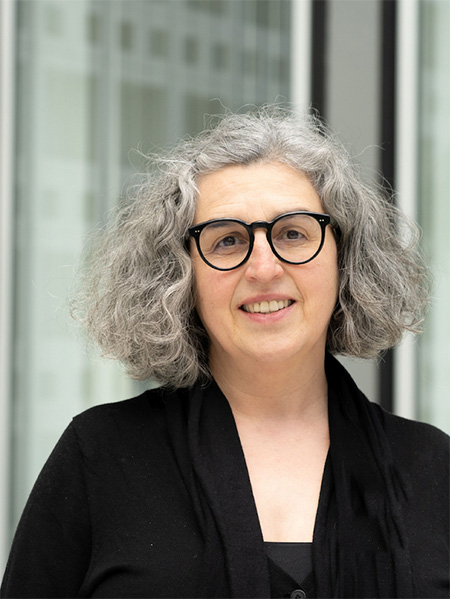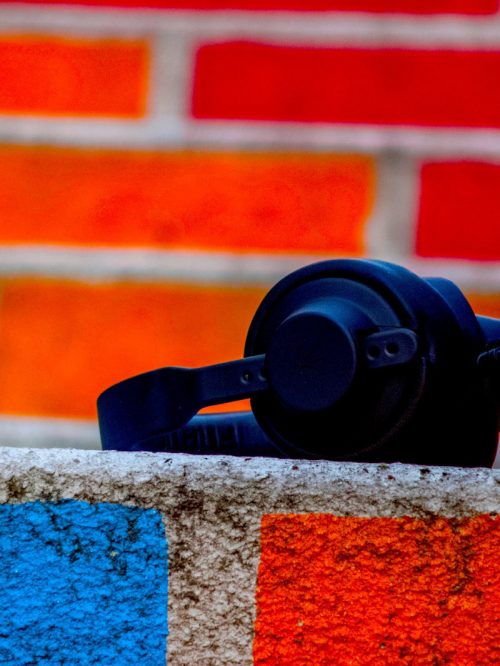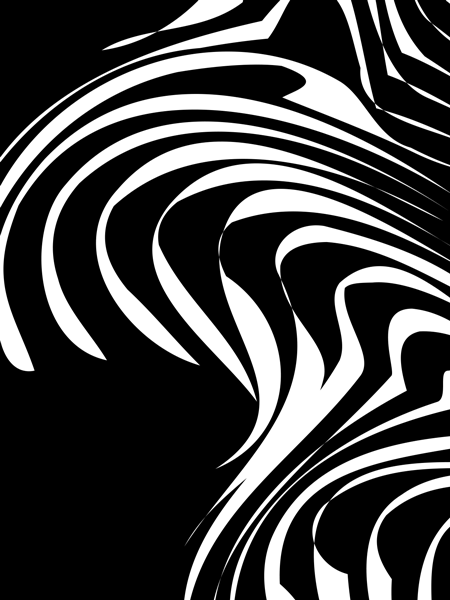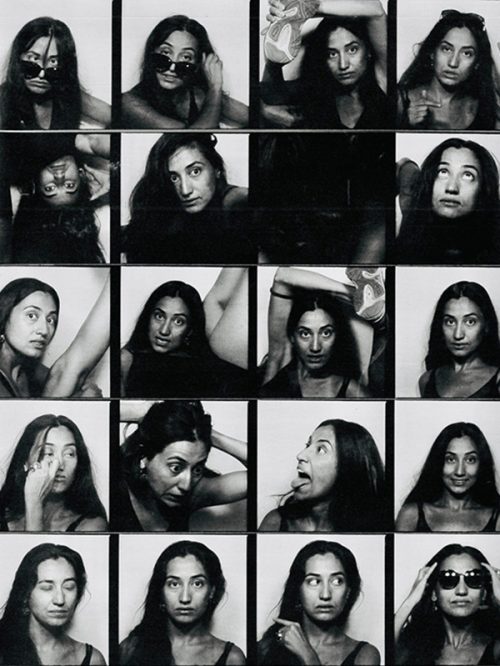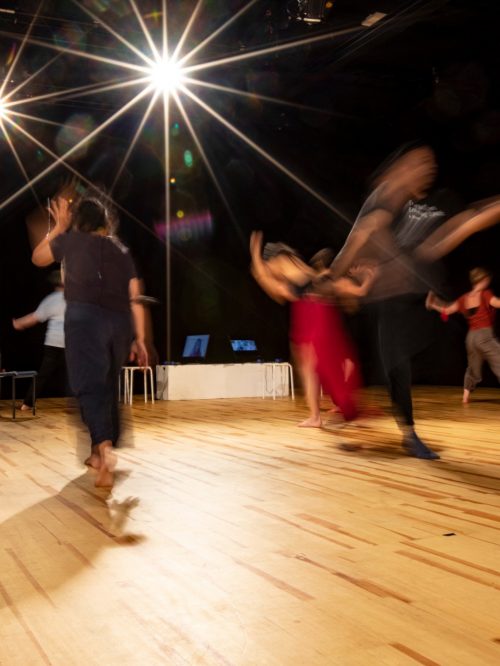OFFSIDE – Reflecting on the gaze and social normative ideas
In conversations about ‘White Gaze’ Sarah and Sandra from CHAKKARs – Moving Interventions asked me whether my gaze (on performance, on time-based representations of the body) had changed over the years. I found this question as interesting as it was unsettling, definitely not something I could answer on the spot. Precisely because in my profession as a dramaturg and dance theorist, I do nothing else but constantly deal with the gaze, the gaze on images of bodies, the gaze on the body, on the normative body, on the desired body, the female body, images of masculinity, etc. Also, I continue to repeatedly scrutinize images in our heads, the incorporation of gazes, spaces of imagination and projection, “right spaces”, etc., the ” banisters of thought” (H. Arendt), because they determine our coexistence, because they shape our societies and are part of the social. As two references, I can point to the series “Begehrte Körper” or the conference “Moving thoughts”, which I curated as part of my research at the Tanzarchiv Leipzig. Moving thoughts is also the title of the volume I published to document the conference.
I have also studied theoretical discourses on art with regard to performance, the time-based representation of the body (theater, dance, music theater, etc.). For a long time, I was preoccupied with the aspect that what I see looks back at me in return. This kind of self-reflection helped me. I wanted to speak (as a person who speaks and writes about dance) about contexts, facts and things in such a way that I simultaneously made myself transparent as a speaker and the position from which I practiced criticism (in the philosophical sense). Of course, I am also influenced and practiced in the study of postmodern and post-structuralist thinkers, Deleuze, but also Derrida, Jean Luc Nancy, Judith Butler, etc., just to do a little unsorted name-dropping.
Taking a look at my own gaze is unsettling and yet seems to me to be an endeavor that could lend itself well to self-questioning, because the gaze is suddenly no longer a self-evident fact, but a complex, multifactorial and challenging matter.
In reflecting on the (white) Gaze, I focus on changing the way I look at things and ask myself questions that make the transformation visible. I try to answer these questions with short reflections.
All beginnings are difficult, which is why I start with the question: what has changed my view?
First of all, I would say reflection and analysis — I’ve always enjoyed that. The object and its critical observation as well as self-criticism consistently keep me thinking.
All well and good, but unfortunately this is not easy to understand, so I’ll try to be more specific: Specifically, what has changed my gaze? What does analysis mean? What does reflection mean?
When I think about an analytical approach, I am talking specifically about the analytical view, the scholarly, objective, critical view … Is that still academic? It is difficult to escape the rambling nature of discourse in the generic settings of universities and other knowledge institutions. It is also difficult to find low-threshold explanatory models that do not use academic language.
So I’ll start again. I want to try a third time and separate two aspects that have both changed my perspective: 1) on the one hand, it is thinking itself, the positions of philosophy that always occupy me and 2) on the other hand, it is certain tools that enable me to analyze and constructively criticize; these are reflexive instruments that help me to show how and that body images are constructed, such as movement analysis or other deconstruction methods. My aim is to be able to uncover — so to say — the arguments of the body and the language of the stage. The thought models of the German philosopher and phenomenologist Bernhard Waldenfels have certainly done a lot for me here, but then also the French philosopher Jean Luc Nancy, the thinking of Deleuze, but also Hannah Arendt. But I don’t think that can be discussed in the context of this soliloquy.
So now the question arises: what is the connection between constructed body images, the gaze and instruments, which somehow sounds like an operating theater or an orchestra rehearsal, a complexity that needs to be explained.
The body is never a given, that is a fact. It is always an aesthetic and cultural, social or political construct or even product, produced from ways of thinking, trained abilities, notions, e.g. of beautiful and ugly, etc. Many diverse and differentiating factors are involved in this process. This has a lot to do with ideologization in communities and societies or with control, paternalism and domination. This was one of the first important discoveries I made during my academic studies.
I would therefore like to look at a concrete, more vivid connection, namely the connection between body and dance techniques, which always have ideologies attached to them, as well as concepts of worldview -0 ideologies can be right-wing, racist, evolutionist, revolutionary, authoritarian, disempowering, humiliating, shameful and hurtful, and so on.
Now there’s a lot being listed, it might even be confusing, can you explain it again in more detail?
I am gladly trying once more, in a different way — I have always been very interested in looking at connections and relationships, e.g. one object in relation to another object; or observing how “A” moves in relation to “B”, or a group of dancers together, etc…. I was less interested in whether what I was looking at was “beautiful” or whether I perceived it as “beautiful”.
I was lucky enough to be able to deal with movement analysis and dance notation in my academic studies. That’s why I would like to move on to the tools I mentioned at the beginning. Movement Evaluation Graphics by Cary Rick and Claudia Jeschke, or William Forsythe’s Improvisation Technologies: A Tool for an analytical dance eye, – an immensely important set of instruments with which one can read movement well and not interpret the bodies that move. Identitarian concepts of the body recede into the background with this approach and play no role in the first place. But also the study of the notations of old, baroque dance masters, or the study of Laban notation or contemporary notations etc. — it is not necessary to list all the methods, that might only seem pretentious. Rather, I can say that all methods of analysis have given me a language. I was able to name what I see. I was able to make different distinctions. I was able to immerse myself in the construction of movement and body and show how dance techniques and movement methods represent worldviews, but also generate them, and thus show an image of the human being that manifests itself not only through skin, hair, costumes, gender, etc. The connection between body weight, which is always pulled or held beyond the body’s center of gravity on the vertical body axis by means of dance technique, especially virtuoso dance technique, occurs in several dance and body techniques, not only in Western ballet. Being able to analyze such moments opens up new possibilities for talking about dance and movement in an intercultural comparison. A way of speaking that can stand up against silence.
Now a leap of thought just crept up on me, going from gazing to speaking and even talking about silence, could be confusing…!
I find these puns interesting because they speak from the collective remembrance and the collective memory. They have a lot to do with perception. Looking away is comparable to silence and in language there is a connection between what I want to keep quiet about and what I don’t want to see. There is also a connection between what one cannot or does not want to talk about and what the gaze cannot bear, e.g. violence, abuse, images of horror, deformation, etc.
And especially in the realm of the aesthetic, we find it very difficult to talk about violence or to recognize it as being present in the creation of art. Many things are considered beautiful, but are based on violence. It is difficult to let go of beauty. It is also difficult to recognize that there is usually at least one flip side to it.
It was not only in my studies and my artistic research that I very quickly came up against mechanisms of exclusion. I was definitely never in a neutral field with my research, but also with the programs I curated, or especially at the theaters or institutions where I workand have worked, but the possibility of deconstruction and construction, of disassembling and reassembling, that also shaped my view, and thus probably changed it – and also always opened up new paths.
What is meant by this – ‘paths opened’?
I think I often didn’t follow what was most obvious, what was vying for attention the loudest. I consciously and unconsciously allowed myself to be taken in by other perspectives. I kept changing the position of my gaze. But I also believe that I always follow a certain logic, structure or perhaps better, a grammar: my attention always ends up with the connection and the interrelationships.
What do changing relationships have to do with exclusion?
At the Leipzig Dance Archive, for example, I was entrusted with the project Politics with Dance and Dance with Politics. I investigated interdependencies between dance, politics and cultural identity based on the estate of the dance critic Fritz Böhme (1881 – 1951). Not at first glance, but definitely at second glance, these documents showed how racism, anti-Semitism and exclusion found their way into the world of dance in Germany at the beginning of the 20th century, and this lasted well beyond the Second World War. Unfortunately, the function, mechanisms and implementation of exclusion have not changed. Exclusion is always part of identitarian concepts and approaches; exclusion is always part of the constructed view of an imagined community – an imagined community is a community that is imagined but does not exist, e.g. the nation state, or nationalist and ethnic communities are imagined. Such communities are fake and must always be deconstructed because they still determine our lives and formulate norms. Such communities always work with exclusion and do not create a sense of belonging or cohesion; on the contrary, they generate cultural heteronomy, impose perspectives and confront us with devaluation and judgment. We are still dominated by the functioning of various concepts of exclusion and are manipulated by them. This can also include the beauty, sports and fashion industries. – Hatred, contempt and humiliation therefore continue to be generated on the basis of the construction of exclusion. Socially and politically, racial ideologies are encouraged; inferiorities continue to be established on various levels: Everything that does not appear acceptable and that does not conform to visual norms is pushed into structural invisibility; (cosmetic) surgery, advertising, wars, but also urban planning or viewing habits etc. can ensure this. In our so enlightened societies, the escape route of ‘conformity’ continues to cause humiliation and shame and establishes the structural other. These principles not only concern communities, but in our century above all capital markets – I would like to point that out here.
That’s probably true, but again it’s a very general statement. Are there any practical examples?
Of course, many examples could be listed. Again, this would go beyond the scope of the self-interview with an agreed and not too extensive number of characters, but there are two practical examples that I can briefly discuss. In the immediate present, I was partially responsible for the project “Gathering in a better world”, which focused on the international networking and visualization of women artists with disabilities, one of the most vulnerable groups worldwide. This work also brought painful experiences, because as a person who was largely socialized in an ableist way, I personally found myself discriminating at times. However, this project also opened up an endless field of learning with wonderful experiences and genuine encounters.
My work as a dramaturge at schauspielfrankfurt goes back a further. Nowadays there are endless discussions about how diverse the ensembles at German municipal theaters should be, and not only that, but I like to remember that almost 20 years ago we had a casting policy that was probably ahead of its time. Antigone and Ismene were cast with women of color. There were two reasons for this: the women were great actresses and we enjoyed working with them. But against the backdrop of common casting norms it was a political act, common ideas were very clearly interrupted, and in my opinion also subversively attacked. But the blueprints and standardized ideas of women that were designed by “(old) white men” were also attacked. And of course these two women contradicted these ideas.
But even more so, we broke the norm and the casting canon by casting a black male actor with a naked upper body in Goethe’s Iphigenia on Taurus. This was very exciting and gave Goethe’s somewhat idealized drama a certain wit and charm, because the idealized classicist images of women were confronted and not interpreted and reinforced. The subjugation of women to male fantasies and projection, the structural inequality of women in society, is and remains a major theme. Redirecting perspectives and breaking down ideologies has always been part of my dramaturgical work. The lively example from the municipal theater makes it clear that norms and normative external regulations that affect women still need to be negotiated. The stage could therefore be an opportunity.
Perhaps now is the time to ask, what attracts my gaze?
I like to look offside. It’s not the mainstream that captures me, at most its dark side. I like the image of the offside, which is a rule in soccer that even many fans don’t fully understand. — I smile at this because I find it very funny.
But now we’re getting away from the point? Isn’t this a diversionary tactic? Isn’t it?
I don’t know about that, and I don’t want to delve into soccer rules, but breaking the rules and injustice go hand in hand. And if my gaze has changed, then it’s definitely in the sense that it literally tracks down visual injustices. In terms of a successful society and community, I am increasingly interested in equality and participation. For me, participation is the opposite of exclusion and norms and the disregard that goes with them. There is a growing tendency to celebrate disregard, misanthropy and exclusion aesthetically again, through advertising, catwalks and mainstream, films, TV, media or election and advertising posters (Germany’s next Topmodel, for example), but also more recently through the reality of wars and the associated images of war. This happens in the mainstream, as in the culture of remembrance and historiography, in authoritarian governments and societies. Art institutions, museums, theaters, concert halls or cinema screens show and articulate many of these grievances in democratic countries, a lot is addressed and can be discussed. These debates are also of great interest to me and I take part in them. My eye has been sharpened for critical debates in particular. At the same time, however, it also makes me powerless and angry when I realize that structurally nothing or very little is changing. It makes me angry to realize that
Thank you for talking to me.
About the author
Dramaturge, curator, author, studied theater studies, philosophy and musicology in Munich from 1988 to 1993. She then worked as a dramaturge for various festivals, theater/dance productions and performance projects. From 2001 to 2008, she worked as a dramaturge at schauspielfrankfurt. She regularly taught at various colleges and universities (Munich, Bochum, Frankfurt, Leipzig, Arnheim, Salzburg, etc.) and curated the interdisciplinary event series Begehrte Körper (1999) and Moving Thoughts (2000) in Leipzig and the exhibition Open the curtain (2003) on the interplay between art and dance at the Kunsthalle Kiel. She has worked as a freelance curator since 2009. Since 2012 she has been working as a consultant for dance, theater and music at the Goethe Institute.
Publications: “Moving thoughts. Dancing is thinking”, (ed., Berlin, Vorwerk 8 2003); “Open the curtain. Kunst und Tanzen im Wechselspiel”, (ed., Kiel 2003); numerous journal articles and essays.


